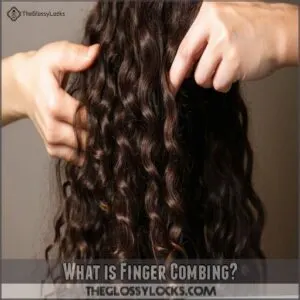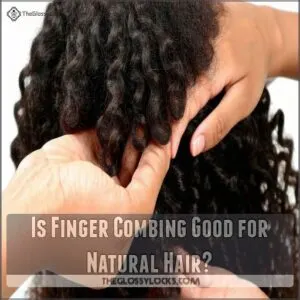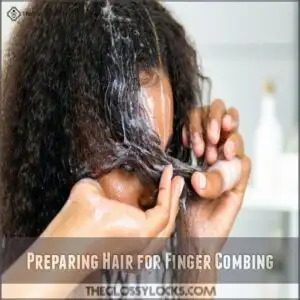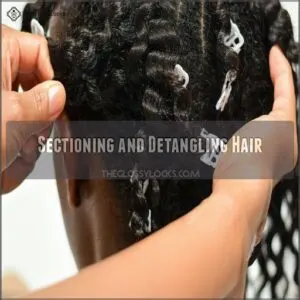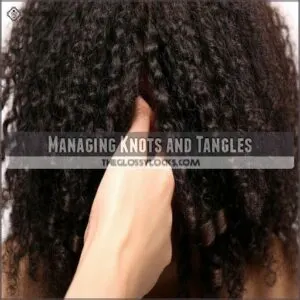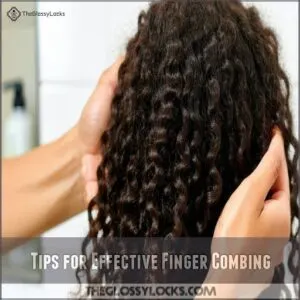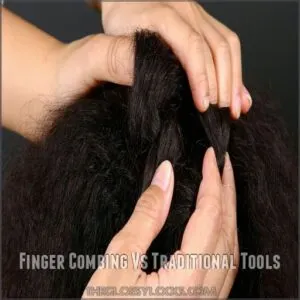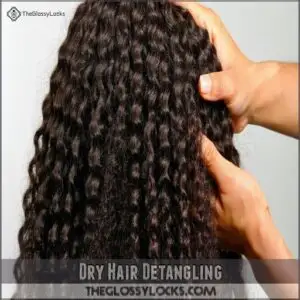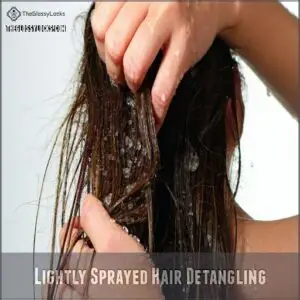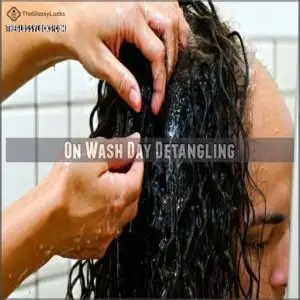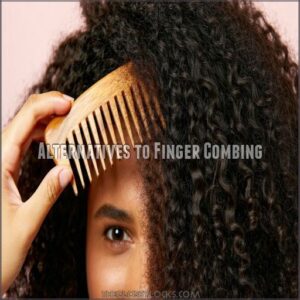This site is supported by our readers. We may earn a commission, at no cost to you, if you purchase through links.
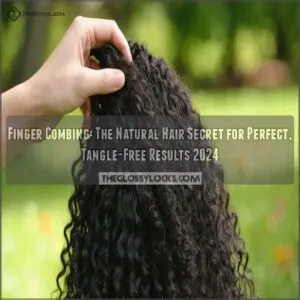
Think of it as a personalized, gentle hair massage. It’s especially great for natural hair, minimizing damage and promoting growth.
Start by sectioning your hair, then gently work through tangles from ends to roots. Remember to be patient—it’s a slower process, but the results are worth it.
Want to know the best techniques and products to pair with finger combing? Keep reading to discover even more hair care secrets.
Table Of Contents
- Key Takeaways
- What is Finger Combing?
- Is Finger Combing Good for Natural Hair?
- Techniques for Finger Combing
- Finger Combing Vs Traditional Tools
- Benefits of Finger Combing for Hair
- Disadvantages of Finger Combing
- How to Finger Detangle Natural Hair
- Alternatives to Finger Combing
- Frequently Asked Questions (FAQs)
- What is finger combing?
- Is finger combing better than a comb?
- Is finger combing good for natural hair?
- Is finger combing good for wavy hair?
- What are the disadvantages of finger comb?
- Should you finger comb your hair?
- Is Finger Combing Suitable for All Hair Types?
- How Often Should I Finger Comb My Hair?
- What Techniques Are Best for Finger Combing?
- What is the Best Way to Store a Finger Comb?
- Are There Any Special Precautions I Should Take When Finger Combing?
- What does finger combing mean?
- Is finger combing good enough?
- How to do finger combing?
- Is it okay to comb hair with hands?
- How often should you finger comb hair?
- Can finger combing prevent split ends?
- Is finger combing suitable for all hair types?
- Does finger combing affect hair texture?
- Can finger combing help with hair growth?
- Conclusion
Key Takeaways
- You’ll love finger combing for gently detangling your hair and reducing breakage, especially with natural curls or coily textures.
- It’s a slower process that requires patience, but it promotes healthy hair growth and minimizes split ends, keeping your hair looking its best.
- Finger combing lets you feel every knot, giving you better control to detangle without causing damage, unlike traditional combs or brushes.
- While it’s effective for many hair types, you might need traditional tools for stubborn tangles or if you are short on time.
What is Finger Combing?
You’ll love how finger combing lets you detangle your hair using just your fingers instead of harsh brushes or combs, giving you complete control over every strand.
When you’re working through those morning tangles, your fingers can feel exactly where the knots are and gently work them loose without causing damage or breakage.
Definition and Purpose
Finger combing, the gentle detangling technique, is your secret weapon for hair health.
Using your fingers instead of hair tools offers a personalized touch that reduces breakage and promotes growth.
It’s tailor-made for natural hair care.
- Personalized: Feel every knot and tangle.
- Gentle: Minimizes breakage with soft detangling.
- Controlled: Provides more care and precision.
Elevate your detangling game effortlessly!
How It Works
Imagine gently coaxing your hair into submission without a comb in sight.
That’s what you’re doing with finger detangling, a technique that uses your hands to glide through tangles.
You feel every hair strand, which means you’re in full control, reducing breakage as you go.
It’s a gentle approach that lets you sense tension and adjust, turning a mundane task into an empowering hair care ritual.
Benefits for Hair
When you’re trying to keep your hair healthy, finger combing can be a game-changer.
It minimizes breakage, promotes length retention, and aids hair growth, all while being gentle on the scalp.
Say goodbye to hair damage and frizz, embracing smoother strands.
It’s like giving each strand personal attention, effortlessly easing through tangles.
Your natural curls will thank you for the detangling ease and improved scalp health!
Is Finger Combing Good for Natural Hair?
If you’ve ever wondered whether finger combing is good for your natural hair, you’re not alone.
This gentle technique is ideal for coily hair types, which are prone to dryness due to their high porosity characteristics, reduces breakage and split ends, helps retain length, and is especially kind to curly and coily hair types.
Reduces Breakage and Split Ends
So, you’ve learned about finger combing.
Now, let’s talk about why it’s amazing for your hair health.
Think of your strands as delicate silk threads—gentle handling is key!
Finger combing prevents breakage and those pesky split ends.
It’s like giving your hair a mini-massage, detangling knots without the harsh tugging of a brush or comb.
This reduces damage, keeping your hair looking and feeling its best.
Say goodbye to damaged hair and hello to a smoother, healthier hair care routine!
Promotes Length Retention
Keeping your natural hair long and strong isn’t just a dream.
By preventing breakage and minimizing split ends, finger combing plays a key role in hair length retention.
Using a detangling product for slip, like a leave-in conditioner or a moisturizing hair cream, can help make the process even smoother.
This technique gives you control over your hair’s destiny, reducing tangles and promoting healthy hair growth.
Say goodbye to frustration and hello to luscious, long locks – it’s like uncovering a secret, magical elixir for hair care.
Gentle on Curly and Coily Hair
Curly and coily hair, with its unique twists and turns, can feel like a stubborn enigma.
Finger combing benefits shine here, as this detangling technique gently navigates your curl pattern without snapping strands.
By embracing this healthy hair routine, you minimize breakage and tangles.
Imagine confidently running your fingers through your hair, feeling each knot giving way to smooth, luscious curls—it’s liberating and powerful.
Techniques for Finger Combing
To master finger combing, a few handy techniques can make your curls thank you.
Finger combing can be used whether you’re preparing your hair, sectioning it carefully, or managing those stubborn knots.
These steps will help you achieve smooth, tangle-free results with ease.
Preparing Hair for Finger Combing
Anyone who’s tried finger combing knows it’s all in the prep. Moisturizing hair is essential before you get started:
- Choose Products: Go for a leave-in conditioner or detangling spray to soften those strands.
- Detangle Knots: Apply the product, and let it sit for a few minutes to tackle stubborn tangles.
- Pre-Wash Prep: Start with damp, clean hair to minimize breakage.
Sectioning and Detangling Hair
Tackling your hair’s tangles starts with mastering sectioning techniques.
Divide your hair into manageable sections using clips, making detangling a breeze.
Each part becomes a puzzle piece, ready for gentle finger detangling.
Spritz a bit of leave-in conditioner for effortless glide.
| Hair Type | Section Size | Detangling Tool | Product Recommendation |
|---|---|---|---|
| Wavy | Large | Wide-Tooth Comb | Light Leave-In Spray |
| Curly | Medium | Fingers | Hydrating Conditioner |
| Coily | Small | Fingers | Slip-Boosting Gel |
| Kinky | Tiny | Wide-Tooth Comb | Moisturizing Cream |
Managing Knots and Tangles
Managing those pesky knots and tangles doesn’t have to feel like tackling a beast.
To minimize breakage, you should prepare your thick hair with a hydrating treatment, such as a leave-in conditioner or a product with nourishing ingredients like detangling spray with olive oil.
Using a bit of patience and understanding the importance of pre-pooing 4c hair types, you’ll find yourself breezing through your detangling routine while keeping your natural hair intact.
Tips for Effective Finger Combing
So, you’ve tackled those knots? Great! Now, for some pro tips on finger combing.
Remember, patience is key—it’s a marathon, not a sprint.
Start with smaller sections, working from ends to roots.
Use a little water or leave-in conditioner to make things smoother.
Don’t force it; gently coax those tangles out.
With practice, finger detangling will become second nature, leaving your natural hair healthier and happier.
Finger Combing Vs Traditional Tools
When you’re dealing with tangles, deciding between finger combing and traditional tools like wide-tooth combs and soft-bristled brushes can feel like choosing between two superpowers.
Each method has its perks, and sometimes combining them offers the best of both worlds for those stubborn knots.
Wide-Tooth Combs and Soft-Bristled Brushes
Imagine taming those wild tangles with the gentle touch of a wide-tooth comb or a soft-bristled brush.
These tools are like the superheroes of hair care, offering detangling tips that won’t let you down.
They glide through knots, minimizing breakage while keeping your hair’s health in check.
Selecting the right comb alternatives can transform your routine, giving you tangle-free freedom!
Comparison of Detangling Methods
While wide-tooth combs and soft-bristled brushes are popular detangling tools, finger combing often provides a more intuitive approach.
This method lets you feel tangles before pulling, unlike traditional tools that may cause breakage.
For a smoother detangling experience, consider adding finger detangling products to your routine.
Finger combing vs. brushes? It’s all about your touch versus tool, making it more personal.
For those with curly or color-processed hair, incorporating a co washing routine can make a huge difference in achieving perfect, tangle-free results. Each hair type benefits differently, so find what works best for you!
Benefits of Combining Finger Combing With Tools
Combining finger combing with detangling tools like wide-tooth combs and soft-bristled brushes can be a game changer.
You’ll enjoy faster detangling and less frizz, making hair days smoother.
It’s like having the best of both worlds: control with your fingers and the efficiency of tools.
This blend enhances results, reduces tension, and provides improved manageability in your natural hair detangling routine. Using a gentle approach, like a wide-tooth comb or soft-bristle brush, helps to minimize breakage and frizz in your natural hair. This blend enhances results, reduces tension, and provides improved manageability in your natural hair detangling routine.
Benefits of Finger Combing for Hair
When you switch to finger combing, you’re treating your hair with the care it truly deserves, which reduces breakage and makes detangling natural hair a breeze.
This method not only helps promote healthy hair growth but also minimizes the pain of dealing with stubborn knots.
Reduces Hair Breakage
Using finger combing lets you feel each strand, offering precise control and minimizing hair breakage.
Unlike traditional tools, your fingers gently untangle knots without causing split ends, paving the way for healthy hair growth.
It turns the dreaded task of detangling into a nurturing hair care routine, offering both you and your natural hair a breakage-free experience.
Easier Detangling of Natural Hair
Less breakage means more length, right?
Finger detangling’s gentler touch is a game-changer for natural hair.
Those frustrating knots and tangles? They melt away with careful fingerwork.
It’s like giving your curls a spa day, one strand at a time.
Say goodbye to the tug-of-war with combs and brushes.
Your detangling routine just got a whole lot easier.
Embrace the power of touch!
Promotes Healthy Hair Growth
Picture your hair thriving, embracing the benefits of finger combing. It’s not just about easier detangling; it nudges your hair toward healthier growth.
How? It reduces breakage, preventing setbacks.
It enhances scalp health by boosting circulation, supports the hair growth cycle naturally, and encourages nutrient intake with every gentle touch.
Let your locks flourish!
Minimizes Pain Associated With Detangling
Sensitive scalps rejoice.
Finger combing minimizes detangling pain by embracing gentle hair care.
Using a hair detangler spray can also help make the process smoother.
This approach allows you to feel knots and tangles, easing them apart without the discomfort traditional tools might cause.
With detangling pain relief, you’ll champion hair breakage prevention and enjoy a calming routine.
Swap stress for serenity, and let finger combing techniques revolutionize your hair care.
Disadvantages of Finger Combing
Finger combing can be quite the time-consuming endeavor, especially when you’re in a hurry and attempting to master it.
Finger combing offers a gentle approach, but don’t be surprised if a few stubborn tangles refuse to budge, needing a bit more than just your fingers to tame.
Time-Consuming Process
Finger combing, while great for reducing hair breakage, can be a bit like watching paint dry—it’s definitely a time-consuming process.
Using techniques like wet detangling methods can help ease the process, especially for dense or coily hair.
Balancing time management with hair density and patience levels might feel like juggling, but alternative methods can help streamline your natural hair care ritual.
Requires Practice and Patience
Moving from the time-consuming process to mastering the technique requires patience and practice.
Here’s your roadmap:
- Consistent practice: Make it a part of your finger detangling routine.
- Patience for hair: Treat each strand like it’s delicate.
- Finger detangling tips: Start slow, don’t rush.
- Natural hair awareness: Learn your hair’s quirks for better results.
Stay persistent—your hair will thank you!
May Not Remove All Tangles
Though finger combing saves your locks from breakage, it may not whisk away all stubborn knots and tangles.
Those pesky knots sometimes cling on, demanding a bit more coaxing.
Consider alternative methods like detangling tools or product recommendations for tricky tangles.
A widetooth comb can help detangling hair if your natural hair needs that extra bit of attention.
Challenging for Dry or Damaged Hair
Sometimes, even with the best intentions, finger detangling just won’t cut it.
Dry or damaged hair? It’s a whole different ball game. Those strands are brittle, prone to snapping.
- Dry hair needs extra moisture.
- Damaged hair requires extra care.
- Use a leave-in conditioner.
- Consider a detangling spray.
- Don’t force it; you’ll cause more harm.
Gentle detangling is key. Think of it like coaxing, not wrestling. A wide-tooth comb might be your new best friend.
How to Finger Detangle Natural Hair
Mastering the secret to tangle-free, natural hair is like finding the right balance between patience and practice—think of it as a mini training session for your fingers.
Finger detangling makes wash days less of a workout and more of a breeze.
Let’s explore three effective methods for finger detangling.
Basics of Finger Combing
Let finger combing be your secret weapon in the battle against hair tangles and knots.
This gentle detangling method involves using your fingers to carefully tease apart strands, giving you more control and reducing hair breakage.
It’s like treating your hair to a soothing spa day, promoting healthy, natural hair that can roam free without breakage worries.
Three Methods of Detangling
Getting the hang of finger combing was quite the feat.
But let’s explore three ways to detangle those pesky knots.
First, work from the tips to roots, carefully unraveling each tangle like a secret thread.
Second, use a detangling conditioner for extra slip.
Third, pair finger combing with lightweight detangling tools when needed.
Tangles, beware!
Dry Hair Detangling
Struggling with dry hair detangling? Embrace finger combing to gently navigate those tangles.
Start by sectioning your hair and using your fingers to carefully untangle knots, minimizing breakage.
Keep your movements slow and steady; rushing can lead to more harm.
Add dry hair products designed for protection.
This approach, especially when combined with understanding your hair’s unique characteristics, such as hair porosity and texture, allows you to maintain control and protect your natural hair’s integrity.
Lightly Sprayed Hair Detangling
When tackling dry hair detangling, a lightly sprayed approach can save the day. Here’s how:
- Grab a spray bottle with water-based detanglers to softly mist your hair, making detangling easier.
- Use your fingers like gentle combs, moving through those stubborn knots.
- Opt for the best sprays like leave-in conditioners to help reduce hair breakage.
On Wash Day Detangling
Wash day detangling can be a game-changer for your hair routine.
Begin by soaking your natural hair, then apply a generous amount of conditioner to add slip.
Gently finger comb through hair sections—let your fingers work their magic! It’s like unraveling a mystery, but instead, you’re releasing curls and embracing freedom from knots.
Alternatives to Finger Combing
Sometimes, even with practice, finger combing isn’t enough to conquer every knot.
Luckily, you’ve got options like wide-tooth combs, soft-bristled brushes, or even a combo of finger combing and tools for a super-smooth detangling experience.
Detangling Tools and Products
Products and tools can make detangling a breeze. Enjoy smooth locks with these handy aids:
- Detangling brushes: Great for removing knots and tangles effortlessly.
- Wide-tooth combs: Perfect for gentle, snag-free detangling.
- DIY detanglers: Try mixing conditioner with water.
- Detangling spray: Adds slip, reducing tugging and pulling.
These tools complement your finger detangling routine beautifully!
Combining Finger Combing With Detangling Tools
Pairing finger combing with the right detangling tools can be a game-changer.
It’s like mixing the precision of finger detangling with the efficiency of a wide-tooth comb.
Opt for tools that match your hair type—whether it’s a brush or comb—to keep your hair happy and tangle-free.
Experiment to find that sweet spot and celebrate smooth, luscious locks!
Be Gentle and Patient
Regarding detangling, being gentle and patient can work wonders for your hair’s health. Imagine it as a conversation you’re having with your strands—they just need time and a gentle touch to cooperate.
- Take breaks if needed; your hair will appreciate it.
- Use your fingers to feel and address every knot.
- Prioritize gentle hair care for long-term benefits.
Use a Wide-Tooth Comb or Soft-Bristled Brush
Everyone’s got their favorite tools, and in terms of taming those unruly locks, a wide-tooth comb or a soft-bristled brush can be your hair’s best buddies.
Skip the pain and stress by using these gentle options to detangle knots and tangles.
They’re gentle on your strands, helping maintain hair texture while keeping the process smooth and easy.
Apply Leave-in Conditioner or Detangling Spray
Taming those tresses? Try lathering on a leave-in conditioner or spritzing a detangling spray.
With a dash of care, they transform your mane into a silky wonder: You can find the perfect leave-in conditioner for your hair at best leave-in options.
- Boosts hair slip, making knots vanish like magic.
- Perfect for every hair texture and type.
- Many DIY detangler options exist for personalized touch.
Unlock an easy detangling experience!
Avoid Using Finger Combing on Dry Hair
Dry hair can be a recipe for breakage disaster if you’re finger combing.
Hair lacks flexibility when dry, leading to breakage and tangles.
Using a technique like the shingling method for curls can also help achieve tangle-free results.
Swap this approach for a well-saturated routine: spritz on a detangling spray or conditioner first.
You’ll find less hassle, fewer tangles, and happier hair!
It’s like wrapping your hair in a protective cushion.
Frequently Asked Questions (FAQs)
What is finger combing?
Finger combing, a gentle way to untangle hair, uses only your fingers, reducing breakage and pain.
It’s like a personal song for your hair, offering more control and sensitivity,
yet requires practice and patience.
Is finger combing better than a comb?
Choosing between finger combing and a comb depends on your hair goals.
Finger combing gently detangles and reduces breakage, perfect for sensitive hair.
Combs offer quick fixes for stubborn tangles when you’re in a rush.
Is finger combing good for natural hair?
When it comes to hair care, finger combing is your natural hair’s best ally.
This gentle method reduces breakage, retains length, and offers better detangling, especially for curly textures, keeping your hair healthy and strong.
Is finger combing good for wavy hair?
You’ll love finger combing for wavy hair!
It’s gentler than traditional combs, reducing breakage and preserving waves.
Just be patient, section your hair, and use a bit of conditioner for smooth, happy hair days.
What are the disadvantages of finger comb?
Like solving a puzzle blindfolded, finger combing takes time and patience.
It’s tricky on dry hair, doesn’t banish all knots, and demands practice, which can feel challenging.
Some tangles will still need traditional tools.
Should you finger comb your hair?
Whether you should finger comb depends on your hair type and patience. It’s gentler, minimizing breakage, but takes time. Consider your hair’s needs and your schedule.
Is Finger Combing Suitable for All Hair Types?
Finger combing works for many, but not all hair types.
It’s great for curly or coily hair, reducing breakage and split ends.
However, straight or fine hair might still require traditional tools for thorough detangling.
How Often Should I Finger Comb My Hair?
You should finger comb your hair as often as needed to prevent tangles and breakage.
Typically, once or twice a week works well, but listen to your hair’s needs and adjust as necessary.
What Techniques Are Best for Finger Combing?
Grab your chance for hair liberation by mastering finger combing:
section hair, mist lightly, and gently detangle with your fingers from root to tip.
Embrace the rhythm, minimizing breakage, and achieving smooth, luscious locks effortlessly!
What is the Best Way to Store a Finger Comb?
Keep your finger comb handy by storing it in a clean, dry place like a drawer or vanity tray.
You might find it useful to designate a specific spot for your hair tools for easy access.
Are There Any Special Precautions I Should Take When Finger Combing?
Finger combing might seem like finding a hair care treasure trove!
But watch your step—work with damp or conditioned hair, be gentle to avoid breakage, and don’t skip sections to make sure thorough detangling without hair stress.
What does finger combing mean?
Detangling your hair gently, using only your fingers, is called finger combing.
It’s a gentler way to untangle knots than using a comb or brush.
It takes practice, but it’s worth it for healthier hair.
Is finger combing good enough?
Ever thought a revolution could start with just your fingers?
Finger combing is gentle and reduces breakage.
It mightn’t tackle stubborn tangles alone.
Pair it with other methods for best results and healthier hair.
How to do finger combing?
Start by dividing your hair into small sections.
Gently work through each section using your fingers, feeling for tangles and knots.
Tease them apart with care, using slight dampness or conditioner for ease.
It’s all about patience!
Is it okay to comb hair with hands?
Using your hands to comb your hair is perfectly fine!
It allows you to feel and gently work through any tangles, reducing breakage.
Plus, it offers a more natural way to manage curls and kinks.
How often should you finger comb hair?
Think of finger combing like tending a delicate garden; you should do it as often as needed, typically every few days, to prevent tangles and promote healthy hair.
Adjust frequency to your hair’s unique needs.
Can finger combing prevent split ends?
Finger combing minimizes hair breakage, which indirectly helps prevent split ends.
By detangling gently, you reduce stress on your hair strands.
But it can’t cure existing split ends.
Regular trims are still necessary for maintaining healthy hair.
Is finger combing suitable for all hair types?
No, it’s not a one-size-fits-all solution. Some hair types, especially fine or fragile hair, might find it too time-consuming or even damaging. Thicker, coarser hair often benefits most.
Does finger combing affect hair texture?
While you might expect finger combing to tame your hair’s wild nature, it actually enhances your natural texture instead.
By reducing breakage, it maintains your unique curls or waves, letting them shine more vividly.
Can finger combing help with hair growth?
You might find that finger combing encourages hair growth indirectly by reducing breakage and split ends, promoting healthier hair.
It’s all about gently detangling without causing damage, letting your hair thrive naturally.
Conclusion
Mastering finger combing is like hitting the jackpot for healthier, happier hair.
This gentle technique, particularly beneficial for individuals with buckshot hair types, keeps your natural curls in check but also promotes hair growth by reducing breakage.
You’ll soon find it a satisfying ritual as you untangle with care.
It might take a bit more time and patience, but your hair will thank you for it.
So, next time you’re ready to detangle, ditch the brush, and let your fingers do the magic!

